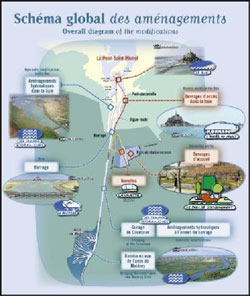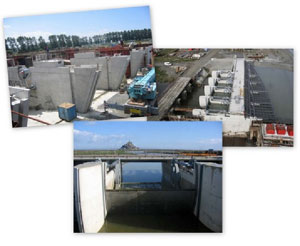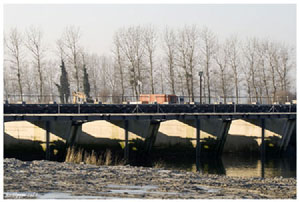Main MenuProductsPartners |
Eiffage chooses Alert for monitoring the Mont Saint-Michel dam.Alert was selected by the Eiffage group, responsible for overall management of work on the Mont Saint-Michel site, for monitoring sluice-gate operation throughout the construction work and ensuring safety during the critical phase of commissioning the dam.
De-silting the bay of Mont-Saint-Michel: one of the most extraordinary ecological projects in existence, aimed at preserving the maritime character of this exceptional site.
Twice a day the worlds highest tides invade the bay of Mont-Saint-Michel. During the spring tides, the sea floods and ebbs over a distance of more than 15 kilometres, between its low water mark on the coast and Mont-Saint-Michel, repeating this ceaseless movement twice a day. With each incoming tide, the water becomes laden with sand and sediments, torn from the surface of the bay by the power of the sea. When the sea retreats, it carries much of this sediment with it, whilst the remainder is deposited in the bay.The rivers then come to the seas assistance, flushing and cleaning out the bay. As only too often, mankind has tried to go against nature by building dykes against the sea and dams on the rivers, in order to win fertile areas of agricultural land, known as polders, from the sea. This has worsened the natural phenomenon of silting, by interfering with the rivers flushing and cleaning action, thus contributing to the gradual rising of the level of the bay and accelerating the choking effect, as shown by the advance of salt marsh vegetation along the shores. Thus, every year more than a million cubic metres of sediment ? the equivalent of one hundred thousand lorry loads! ? accumulate in the bay. Man has now decided to take action against this phenomenon. In 1995, the French State, the regional authorities of Lower Normandy, Brittany and the municipality of Mont-Saint-Michel signed the project for the restoration of the maritime character of Mont Saint-Michel.
The dam, keystone of the de-silting projectConstruction of the new dam will allow production of water flows strong enough to clear away the sediment accumulating around Mont-Saint-Michel. These water flushes will be divided, by a flow-splitting structure, into two separate channels, through which the Couesnon will be able to meander amply. This general mechanism was elaborated on the basis of four years of hydrology and sedimentology studies and research, conducted by the Sogreah specialised laboratory, and is designed to avoid any interference with the natural process of sedimentation in the Small Bay. The whole of this development work was approved by an international scientific Committee. The projects effects were analysed by means of an impact study, in order to optimise their positive consequences for the bay environment.
The selection committee was enchanted by the groups project, thanks to its great technical, architectural and environmental coherence. It is the outcome of detailed observation of the site and puts forward a perfectly adapted solution. Both unobtrusive and elegant, the new dam uses tried, tested and entirely reliable techniques. Filling and flushing operations will be effected by eight sector-sluices, each operated by two cylinders. It blends in with the river banks and dykes. Its appearance will change according to variations in the water level caused by the action of the sluices-gates, becoming almost invisible when they are completely open. The Eiffage group at Mont-Saint-Michel: joint project managementEIFFAGE is Europes 7th largest construction and concessions group. With 56,000 employees, of whom more than 80 % are employee-shareholders, the group has a turnover in the order of 10 billion euros. "The Forclum business entity was selected to manage general supervision of work on the Mont-Saint-Michel dam site, from laying of the electric cables to operation of the Programmable Logic Controllers" specifies Thierry Desert, project manager. Work on this ambitious project has been in progress for over two years. Eventually, management will be handed over to the final operator of the dam, which is due for completion in the course of 2009. However, for the duration of the work, project management has been entrusted to a group of three companies, including Forclum, in charge of operation and monitoring, the dam already being partially commissioned. Initial operation of the dam: a particularly critical phase which is rigorously monitored thanks to Alert"This project required sensitive management because proper functioning of the dam had to be ensured whilst it was still undergoing construction, with all of the unknown factors which such a project implies. At the time of commissioning the dam, numerous adjustments were necessary in order to adapt to a constantly changing environment. We are dependent upon the tides and every tide is different!", notes Thierry Desert. "We therefore required a highly effective and reliable Centralised Technical Management tool to take care of monitoring the dam during the most critical phase of its commissioning" he continues. Three Schneider Programmable Logic Controllers were installed: one on each bank and the third at the dam control centre. These are linked to the PcVue SCADA solution, developed by Arc Informatique, which since its development in 1992 has become an international reference in installation monitoring and control.
In case of problems, the person on-call receives an alarm via Alert on their mobile telephone. This person is informed of the nature and location of the problem on-screen, and takes charge of contacting the appropriate actor for its resolution. If the latter does not resolve the problem signalled, I then receive the alarm message and personally take charge of handing it over to the competent person on the ground Thierry Desert observes. "In fact we use Alert both for alarm management in case of system faults and as a data reporting tool on the operation of the installation. The person on-call receives an SMS message an hour before and an hour after each tides theoretical time, thus allowing systematic verification that the sluice-gates have indeed been properly opened and closed at the appropriate moment". Four separate data reports are thus managed by Alert every day, quite apart from any faults. Actual alarms were most frequent at the time of commissioning, when the project managers had to continuously adapt the site to tidal changes and inherent variations. "During this critical phase, which required great vigilance and the monitoring of a large number of parameters, Alert made it possible for us to ensure optimum safety of the installation without obliging the person on-call to be perpetually present" enthuses Thierry Desert. Alert: a tried and tested choice which has proven its effectiveness"The project specifications imposed the use of a remote-controlled alarm system, with a specific call number for each major type of alarm, without however requiring precise data on the nature or location of the problem. By using Alert, we therefore significantly improved upon the specifications during the provisional operation stage, since Micromedia Internationals solution provides precise information on the nature and location of problems arising Moreover, I had no difficulty in convincing my partners of the value of the Alert solution, with which I was already very well acquainted, having successfully used it on previous occasions. The key factors in favour of this choice were mobility of the person on-call, reliability of information and ease of use" Thierry Desert recalls. |
References
Support |



 The Grand Project for the de-silting of Mont-Saint-Michel constitutes one of the worlds foremost ecological engineering projects. It is made up of four principal actions:
The Grand Project for the de-silting of Mont-Saint-Michel constitutes one of the worlds foremost ecological engineering projects. It is made up of four principal actions: The new dam was the first of the development projects on which work commenced at the end of 2005. Designed for effective management of the river Couesnons flushing action, the new structure will produce ebb tide flushes, in order to restore the maritime character of the Monts surroundings, year after year.
The new dam was the first of the development projects on which work commenced at the end of 2005. Designed for effective management of the river Couesnons flushing action, the new structure will produce ebb tide flushes, in order to restore the maritime character of the Monts surroundings, year after year. Almost 300 variables are thus continuously monitored, divided into 4 categories:
Almost 300 variables are thus continuously monitored, divided into 4 categories: